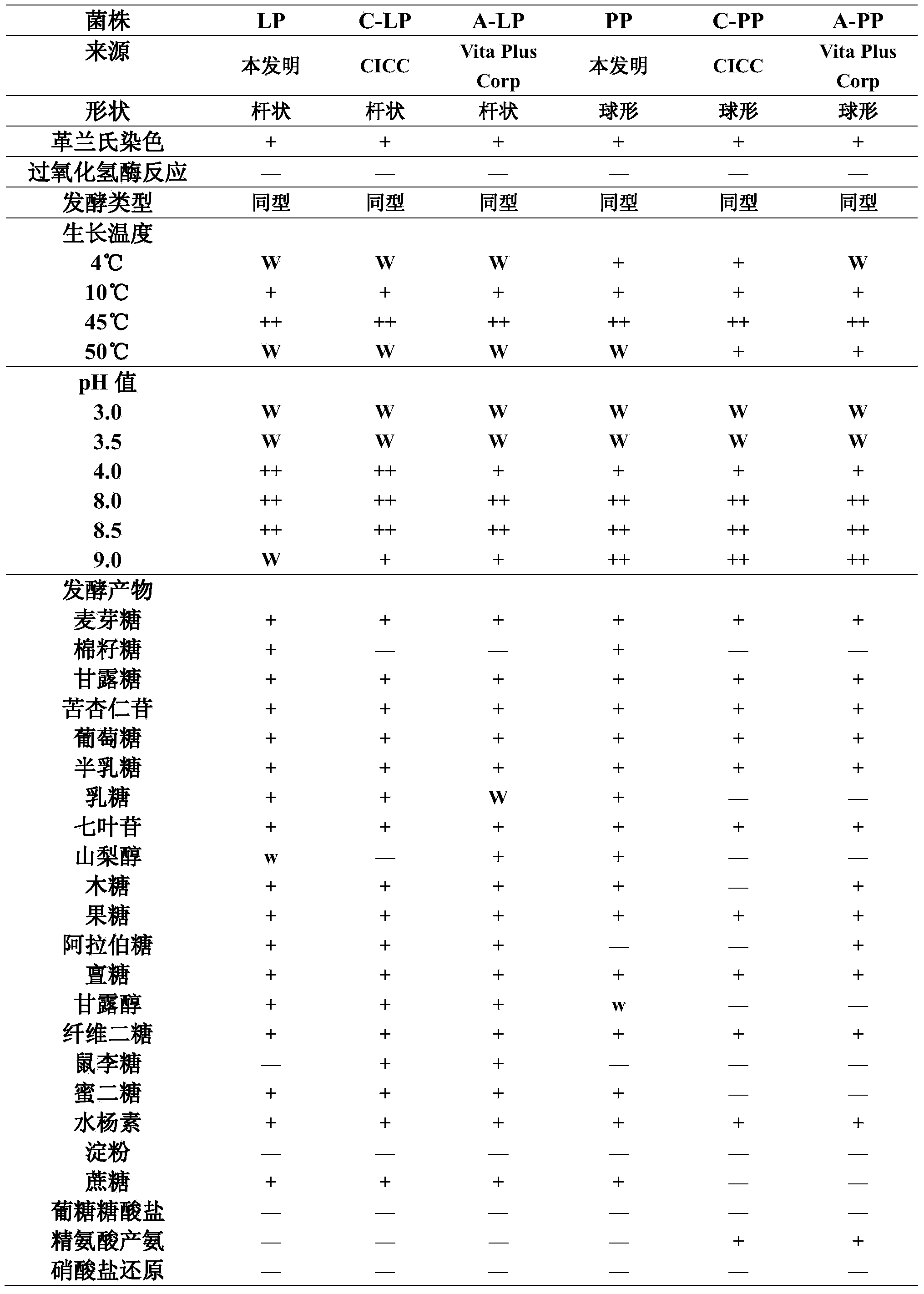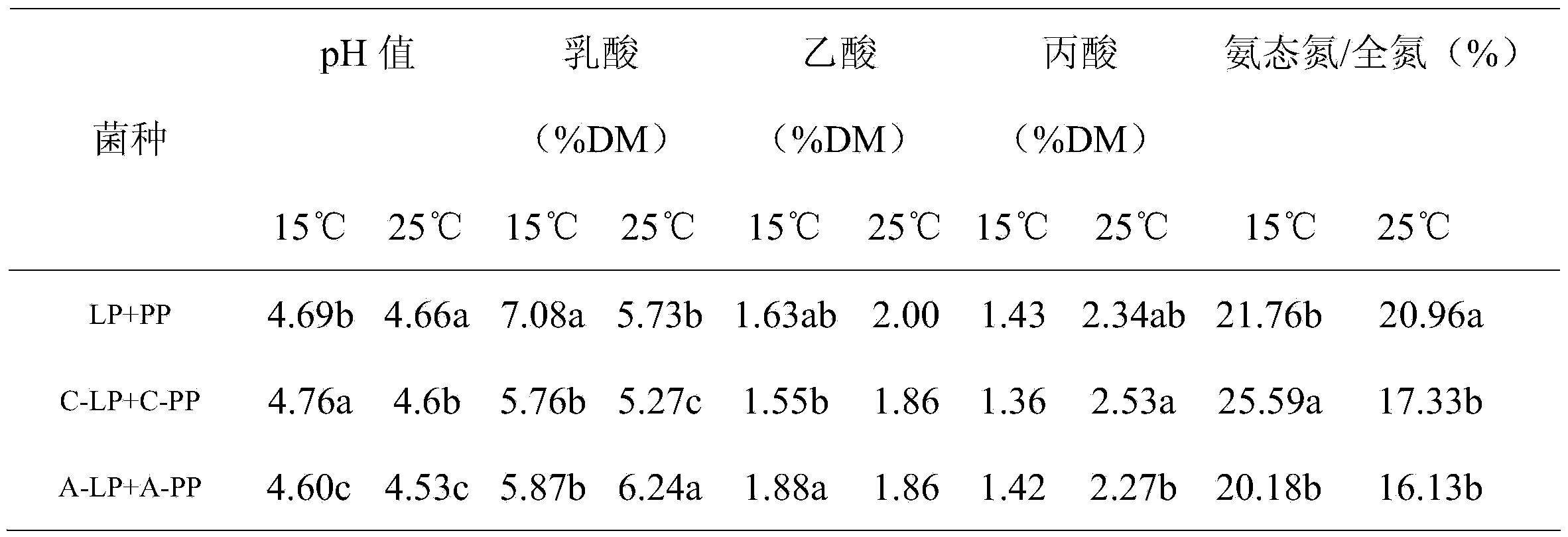Low-temperature-resistant lactobacillus planetarium and application thereof
A technology of Lactobacillus plantarum and microbial strains, applied in the application, bacteria, microorganisms and other directions, can solve the problem of low number of lactic acid bacteria, and achieve the effect of low cost, excellent performance and improving the quality of silage.
- Summary
- Abstract
- Description
- Claims
- Application Information
AI Technical Summary
Problems solved by technology
Method used
Image
Examples
Embodiment 1
[0022] The isolation and identification of embodiment 1 lactic acid bacteria
[0023] In the ultra-clean workbench, unseal and sample the silage samples of Echinopsis chinensis on the Qinghai-Tibet Plateau, weigh 10 g in a sterile environment, put them into a 250 mL triangular flask filled with 90 mL of sterile saline, shake at 180 r / min at room temperature for 60 min, And with sterile water according to 10 -1 to 10 -5 Dilution was carried out, an appropriate concentration was selected, and lactic acid bacteria were cultured in an anaerobic environment at 37°C by using the plate streak method. After 48 hours of culture, according to the color, size, luster, transparency, etc. of the lactic acid bacteria colony, pick a single colony with a transparent circle, and carry out Gram staining, catalase and oil microscope inspection. The catalase-negative strains were suspected to be lactic acid bacteria, and they were separated, purified and cultured twice on the MRS medium by stre...
Embodiment 2
[0025] Embodiment 2 Screening of low temperature resistant lactic acid bacteria and comparison of physiological and biochemical characteristics
[0026] Collect ryegrass at the booting stage, mix it with water at a ratio of 1:2.5, use a juicer to obtain green juice fermentation liquid, filter through 4 layers of gauze, centrifuge at 1000rpm / min for 5min, take the supernatant and sterilize it. After cooling down, inoculate the identified strains into the green juice fermentation broth at an inoculation amount of 3%, place them in 15°C and 25°C incubators for cultivation, measure the pH value of the fermentation broth after cultivating for 3 days, and screen out the low temperature conditions respectively. Lowering the fermentation pH value is better for Lactobacillus plantarum (LP) and Pediococcus pentosaceus (PP). The Lactobacillus plantarum (LP) is preserved in the General Microbiology Center of China Microbial Cultures Preservation Management Committee. The preservation plac...
Embodiment 3
[0037] Embodiment 3 adds this lactic acid bacteria to the effect in the silage
[0038] The Qinghai-Tibet Plateau Elymus silage is used as the raw material for silage, and the silage is dried indoors for about 18 hours, cut to 2-3 cm, and inoculated with the Lactobacillus plantarum and Pediococcus pentosaceus as the compound strain LP+PP The ratio of the effective number of viable bacteria of the Lactobacillus plantarum to the Pediococcus pentosaceus is 1-2:1.2-1.5. The Qinghai-Tibet plateau Elymus chinensis was used as the silage raw material, and the Elymus chinensis was aired indoors for about 18 hours, cut to 2-3cm, and inoculated with commercial compound bacteria C-LP+C-PP and A-LP+A-PP to In silage raw materials.
[0039] Press 10 respectively 6 Spray the lactic acid bacteria preparation dissolved in water evenly at the ratio of cfu / g FM, put it into a polyethylene bag, vacuumize it with a vacuum packaging machine and seal it, place it at 15°C and 25°C for 50 days, the...
PUM
 Login to View More
Login to View More Abstract
Description
Claims
Application Information
 Login to View More
Login to View More - R&D
- Intellectual Property
- Life Sciences
- Materials
- Tech Scout
- Unparalleled Data Quality
- Higher Quality Content
- 60% Fewer Hallucinations
Browse by: Latest US Patents, China's latest patents, Technical Efficacy Thesaurus, Application Domain, Technology Topic, Popular Technical Reports.
© 2025 PatSnap. All rights reserved.Legal|Privacy policy|Modern Slavery Act Transparency Statement|Sitemap|About US| Contact US: help@patsnap.com



